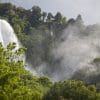What to do in Umbria in April? UmbriaSì tells you
Umbria in April dresses up in spring, offering a perfect mix of traditions, spirituality and lush nature.
With Easter coming, this month becomes a special time to discover the green heart of Italy.
Here are our three tips on what to do in Umbria in April

Experience the evocative Easter celebrations
Easter in Umbria is a unique spiritual and cultural experience. Attend religious celebrations in symbolic places such as the Basilica of San Francesco in Assisi or the Cathedral of San Lorenzo in Perugia. In villages such as Gubbio or Orvieto, Easter traditions come alive with historical re-enactments, processions and events that involve the entire community. The Good Friday Procession in Todi, for example, is an evocative and emotional moment.

Immerse yourself in blooming nature
In April, Umbrian nature is at its most splendor. Take a walk through the flowery meadows and olive groves, or explore the paths of Mount Subasio or the Trasimeno Lake Park, where breathtaking views combine with the perfect spring climate. Take advantage of the season for an outdoor picnic or to explore the flowery gardens of historic villas.

Taste the authentic flavors of Easter
Umbrian cuisine celebrates Easter traditions with unique dishes. Don’t miss the Torta di Pasqua, a delicious savory bread to be enjoyed with capocollo and local cheeses, or the classic roast lamb. Visit local markets to discover fresh products and typical sweets such as Ciaramicola, a shortcrust pastry cake covered in meringue and colored sprinkles. Complete your trip with a glass of Grechetto or Sagrantino wine, perfect for enhancing the Umbrian flavors.
 We are waiting for you in Umbria
We are waiting for you in Umbria 
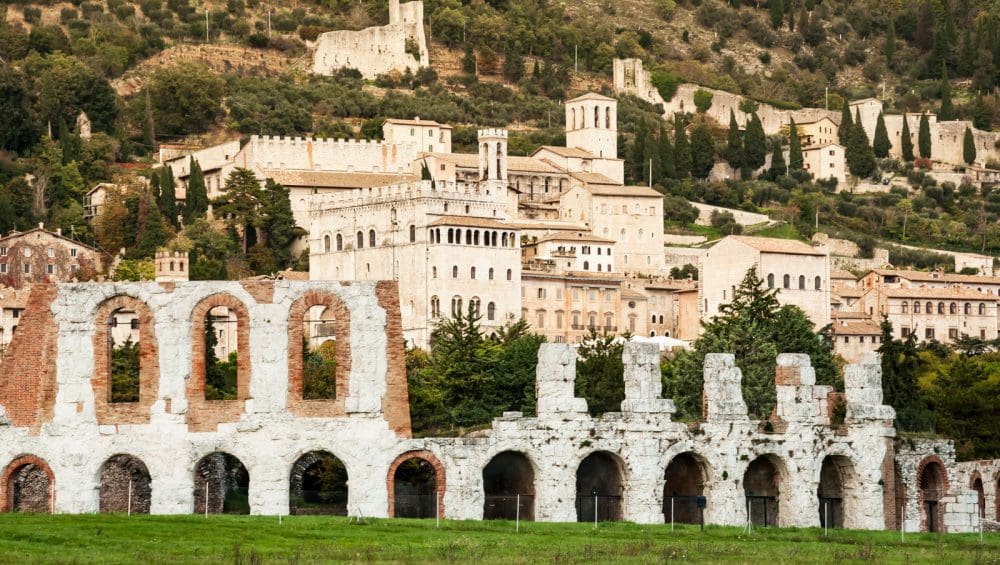
Gubbio a journey through time between history, legends and taste
Imagine walking through ancient stone alleys, with the scent of truffles mixing with the fresh mountain air. Gubbio is a dive into the past, a village that seems suspended in time, ready to give you an authentic experience, between culture, breathtaking views and gastronomic delights.
The day begins with the arrival in Piazza Quaranta Martiri, where our guide will welcome you to reveal the secrets of this unique city. From here, we climb towards Piazza Grande, a terrace suspended between sky and stone, from which the gaze is lost over the Umbrian hills. We visit the majestic Palazzo dei Consoli, guardian of the ancient Tavole Eugubine, evidence of the Umbrian civilization.
But the real spectacle is found even higher up: a cable car ride takes us to the Basilica of Sant’Ubaldo, where an unforgettable view of the city and the history of the patron saint of Gubbio awaits us, protagonist of centuries-old traditions such as the famous Festa dei Ceri.
At this point, the appetite makes itself felt and there is no better way to satisfy it than with a typical lunch in a historic trattoria. Gubbio is the land of the crescia calda, first courses with truffles and succulent second courses, perhaps accompanied by a glass of wine. A journey through Umbrian flavors that is not easily forgotten.
After lunch, our walk takes us to the Church of San Francesco, where the extraordinary friendship between the Saint of Assisi and the wolf of Gubbio is told, a story that still echoes within these sacred walls today. Then, some free time: you can lose yourself among the local craft shops, discover the traditional Eugubine ceramics or let yourself be won over by the typical products to take home as souvenirs.
In the late afternoon, with hearts full of beauty and hands perhaps laden with delicacies, we say goodbye with the promise to return. Because Gubbio is not just a destination, it is an experience that stays with you.
Do you want to discover Gubbio in one day? Contact us for a tailor-made excursion!
 We are waiting for you in Umbria
We are waiting for you in Umbria 
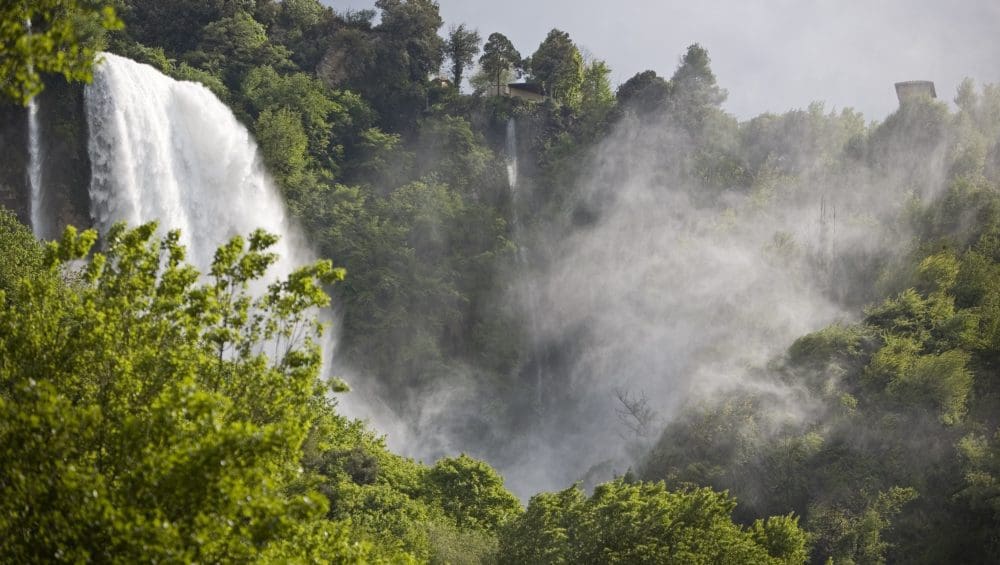
Marmore’s Fall
The Marmore Falls, formed by the Velino and the Nera, tributaries of the Tiber, is one of the most visited natural attractions in Umbria, although it is an artificial waterfall, it has very ancient origins that date back to Roman times, in 271 BC: it is on this date that the Roman consul Manio Curio Dentato with an ingenious hydraulic intervention, built a canal in order to drain the stagnant waters of the Velino into the Sabina (Rieti plain), dangerous for the nearby population, towards the Nera river. The intervention was thus called and known over time as “Cavo Curiano”.
Other interventions made to counteract flooding during periods of river flooding date back to 1422, by the engineer Aristotile Fioravanti and entrusted by Braccio Fortebraccio da Montone. On this occasion a new canal called “reatino” was built. Other interventions date back to 1547 by Antonio Da Sangallo, commissioned by Pope Paul III with the construction of a third canal. In 1601 the architect Giovanni Fontana built the “Clementino” canal in honor of Pope Clement III. Finally in 1787 the architect Andrea Vici made the last intervention that gave the Marmore Falls their current appearance.
To date the Marmore Falls is the highest artificial waterfall in Europe.
CURIOSITIES
- The name comes from the richness of calcium carbonate on the rocks that resembles white marble.
- Today the waterfall is not only an important tourist and naturalistic attraction for the richness of flora and fauna, from algae, mosses, ferns, insects, fish, reptiles, birds and small mammals, but it is also used for hydroelectric production.
- The waterfall is not always open at full capacity (Pay attention to the opening hours so as not to miss this fascinating moment!!), and this allows you to admire the beauty and richness of the vegetation that is shown when the flow of water of the waterfall is closed. Its opening is announced through an acoustic signal. The sight of the water that throws itself with force and creates, on sunny days, a wonderful rainbow is wonderful. The waterfalls can be accessed from both the upper and lower Belvedere.
- At night, the waters of the waterfall, when open, are illuminated by a LED lighting system.
- The beauty of the Marmore Falls Park is also given by the ability to admire along the route the caves that the water has dug over the centuries with stalactites and stalagmites in the travertine: some can be visited and the most famous is the LOVERS’ CAVE
A ROMANTIC LEGEND
The Gnefro, a legendary fairy creature of Umbrian popular culture, tells the story of the nymph named Nera infatuated with the shepherd Velino. The goddess Juno, who did not accept a love between a nymph and a human being, transformed the Nymph Nera into a river. Velino, believing that the Nymph Nera was drowning in those previously unknown waters, threw himself into them. However, Jupiter, moved by pure love, also transformed the shepherd Velino into a river. From then on, the river Nera and the river Velino could stay together for eternity.
DID YOU KNOW THAT
- The soprano Gina Palmucci, deeply in love with her territory, being of Terni origins, chose as her stage name Nera Marmora;
- The Marmore Falls have been painted by several painters and described by important literary figures such as Lord Byron;
- It is present in many films such as Intervista by Federico Fellini in 1987, the Stendhal Syndrome by Dario Argento in 1996, and also in fiction such as Don Matteo;
- In 2011 it was the location for the concert with the orchestra
“I Filarmonici di Roma” and in 2012 the concert for the “Tributo a Sergio Endrigo” by Simone Cristicchi; - In 2017, it was the protagonist of the advertising campaign for the promotion of Tourism in Umbria together with the former Italian diver Tania Cagnotto;
- In January 2023, it was the location for the external test of the MasterChef program.
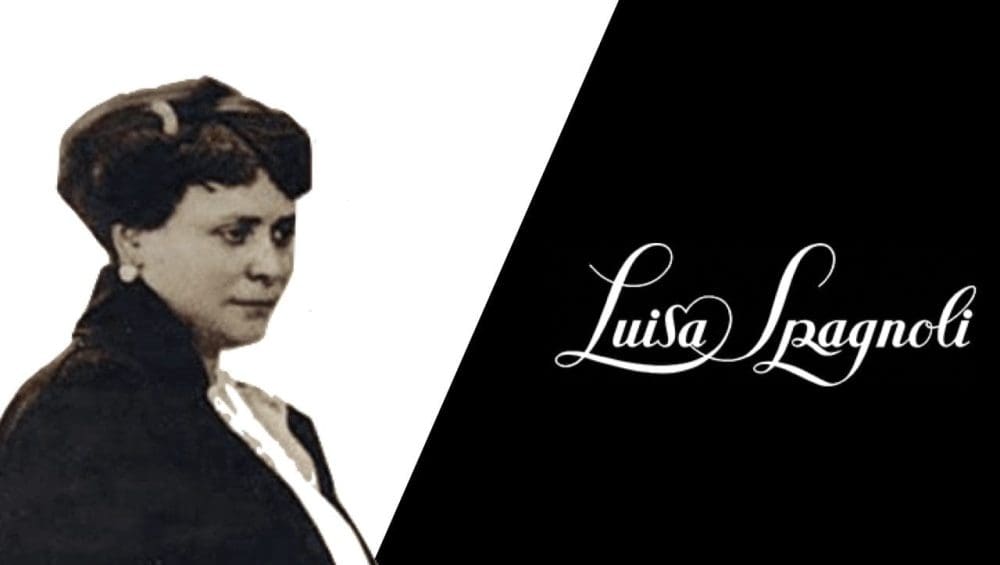
The Women of Umbria
On the occasion of March 8th, International Women’s Day, we want to celebrate it with some of the female figures who symbolize Umbria, a land rich in history, art, culture, and spirituality. Luisa Spagnoli, Marchioness Elena Guglielmi, Maria Vittoria Semolesti, Saint Clare of Assisi, and Saint Rita of Cascia… Women symbols of entrepreneurial spirit, faith and devotion, and still universal values of strength, courage, and independence, which continue to inspire women and men all over the world.
Luisa Spagnoli
A name that immediately evokes images of refined fashion and chocolaty delights. However, her legacy goes far beyond catwalks and delicacies. After the devastations of World War II, Luisa Spagnoli became passionate about Angora rabbits, not only starting to collect them but also discovering a secret that would revolutionize the world of fashion: the art of combing, rather than shearing, these animals. A gentle gesture that allowed for a yarn of unprecedented softness, a fabric that caressed the skin like no other. And what about her delicious chocolates? The Bacio Perugina is a name known all over the world, but there’s another bar that bears her name, a creation some Perugians affectionately call “Carrarmato” (“Tank”), perhaps as a tribute to her tenacity and strength of spirit.
Saint Chiara of Assisi
Born in Assisi in 1194, Chiara Offreduccio degli Scifi, better known as Saint Clare, was a revolutionary figure of her time. A friend and follower of Saint Francis, Clare renounced her comfortable life to embrace a life of poverty and service. The founder of the Order of Poor Clares, she placed prayer and dedication to others at the center of her existence, becoming a model of inner strength and determination.
Saint Rita of Cascia
Saint Rita, born Margherita Lotti in Roccaporena, near Cascia, in 1381, is known all over the world as the saint of impossible cases. Her life was marked by great suffering and challenges, from her youth, when she was forced to marry against her will, to the death of her sons and her husband’s illness. Despite the adversities, Saint Rita found refuge in the Augustinian monastery of Cascia, where she lived until her death in 1457. Her tomb, located in the Sanctuary of Saint Rita of Cascia, attracts thousands of faithful and visitors every year, testifying to the power of hope and perseverance even in the most desperate situations.
Elena Guglielmi and Maria Vittoria Semolesti
At the beginning of the 20th century, Marchioness Elena Guglielmi brought the technique of Irish lace making to Isola Maggiore in Lake Trasimeno, inspired by the traditions born in Irish monasteries at the end of the 19th century, according to the ancient art of Venetian lace. Instead of being made with needle and bobbins, the peculiarity of this lace is created with a crochet hook using an extremely thin yarn. In 1963, the islander Maria Vittoria Semolesti restarted the activity by founding a cooperative of lace makers for the sale of Irish lace.
Photo credits by:
Cittàdelladomenica.it
NestlèItalia.it

What to do in Umbria in March? UmbriaSì tells you
With the arrival of spring, Umbria awakens in a riot of colors and scents. March is the perfect month to discover this enchanted land, where culture, nature and authentic flavors meet.
Here are our three tips on what to do in Umbria in March

The magic of nature reborn
In March, the green heart of Italy offers a unique spectacle: flowery meadows, verdant hills and trees in bloom create postcard-like landscapes. It is the ideal time for walks in natural parks, such as Mount Subasio or the Trasimeno Lake Park, where the tranquility of nature completely envelops you. If you love photography or simply want to breathe pure air, you will find your corner of paradise here.

Authentic and less crowded villages
Spring is perfect for exploring the charming Umbrian villages calmly and without the summer crowds. Discover the flower-filled alleys of Spello, stroll among the medieval walls of Montefalco or lose yourself in the narrow streets of Gubbio and Todi. In addition to the architectural beauty, you will enjoy a warm welcome and an authentic atmosphere.

Seasonal Umbrian Flavors
March brings the fresh flavors of spring to the table. Enjoy first courses based on marzolino truffle, wild herbs and wild asparagus, which enrich traditional Umbrian recipes. Stop at a trattoria or agritourism to enjoy a genuine culinary experience, accompanied by a glass of Grechetto or Rosso di Montefalco wine.

 We are waiting for you in Umbria
We are waiting for you in Umbria 

Carnival sweets in Umbria
The ancient Latin saying reads
“semel in anno licet insanire – once a year it is permissible to go crazy”
Carnival Origin
The common thread that binds Carnival, the mask or masquerade party par excellence, all over the world seems to be precisely the concept that is furthest from what the Romans called mos maiorum, good morals, morality.
But before we get to the Romans, let’s take a few steps back.
The origin of the Carnival dates back to 4000 years ago with the Egyptians and the rites in honor of Isis, the goddess of fertility.
With the Romans, the Carnival Festival coincided with the Lupercali, in honor of the God Luperco, symbol of Roman fertility. The period, for both Egyptians and Romans, is celebrated at the end of February.

Sacred and Profane
The Carnival, between banquets, parties and masks, thus becomes a sort of social “level”: a disguise that hides the status of belonging and allows everyone to set aside moral rigidity for a day.
With Christianity, Carnival from the Latin “carnem levare”, Shrove Tuesday becomes the last day to eat meat before abstaining from consuming it during the period of Lent but also the last opportunity to fill your belly with sweets rich in sugars!
Tipical sweety food in Umbria
Whether it’s Egyptian, Roman or Christian, the “reasons” of Carnival are disguise (masquerade) and the consumption of food, especially sweets!
Let’s see what are the typical ones in Umbria:
- Frappe
Strips of sweet puff pastry in the shape of a bow. Covered with alchermes sugar or honey, they can be either fried (as per the original recipe) or baked in the “lighter” variant. In any case, the result is a crunchy, sweet and tasty pastry.
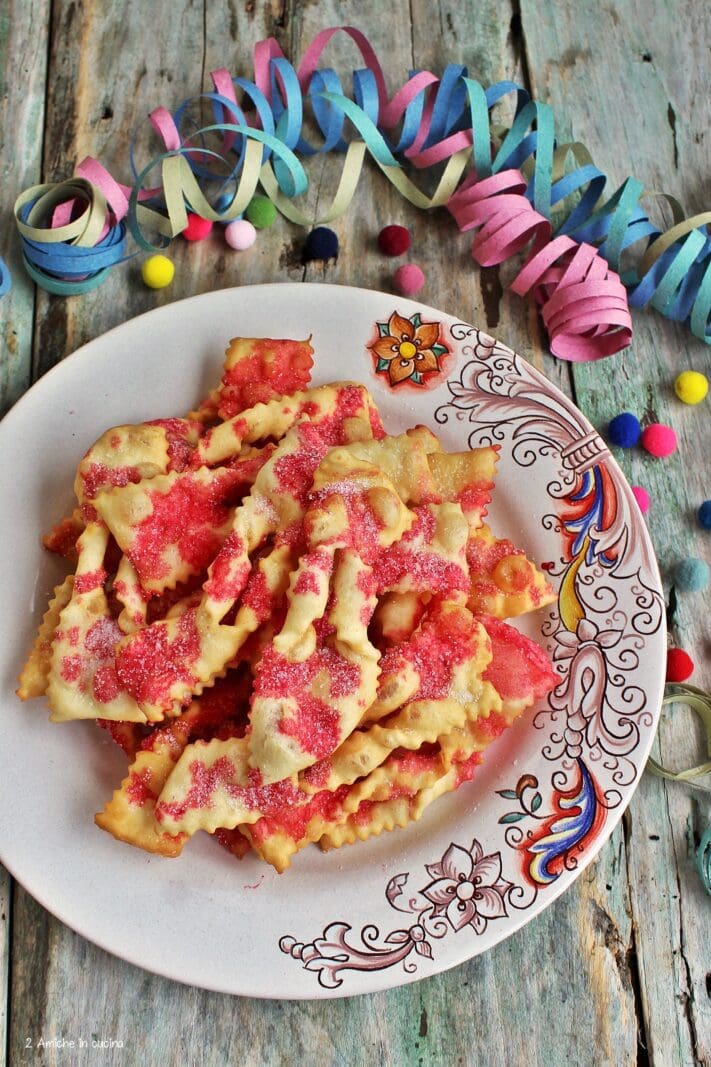
- Castagnòle
The name derives from the memory of the small chestnuts with their rounded shape. The dough is composed of flour, eggs, sugar, yeast and an aromatic liqueur. Also these sweets, as per tradition, are fried paying particular attention to making them golden on the outside and cooked well inside, helping them to remain round during cooking by moving the pan in a rotating direction. Then covered with sugar, honey or alchermes. - Strufoli
Traditional from Perugino, they resemble castagnole with the difference of having a softer texture and are, on the other hand, larger in size. They are then covered with sweet dripping honey.
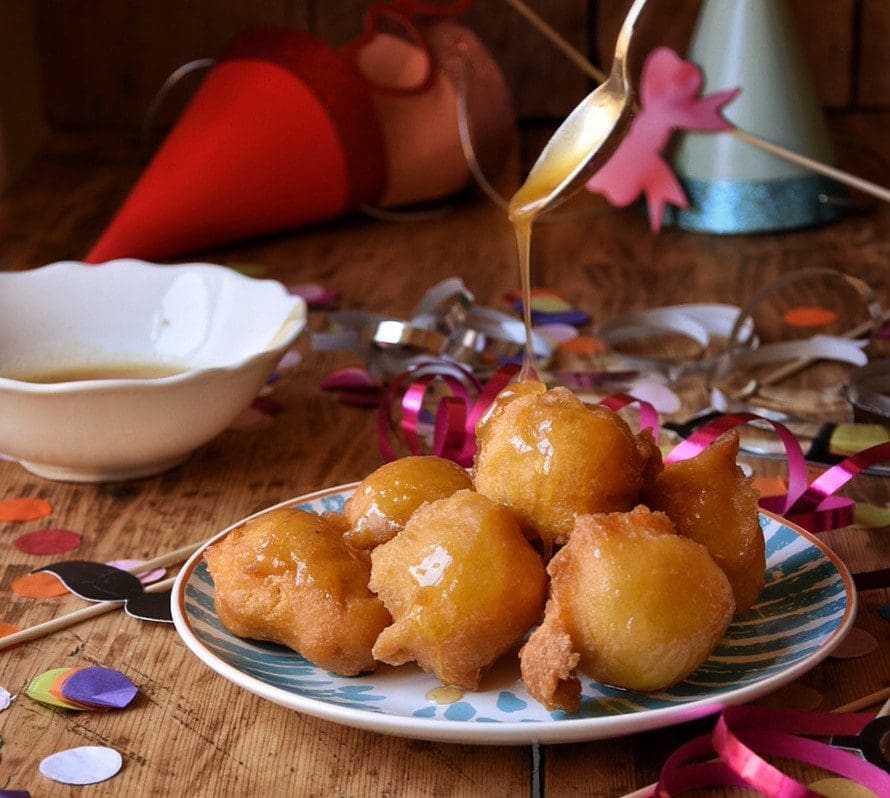
- Cicerchiata umbra
From the name of the Umbrian Cicerchia, a rounded legume, the cicerchiata is a crown of sweet balls covered in honey.

- Crescionda spoletina
With this dessert we move to Spoleto with its Crescionda.
Originally prepared with chicken broth, or lard, in fact also known as “grescia unta” for being particularly fat, sugar, cheese, chocolate and breadcrumbs were then added. Or the version prepared with apples and dried fruit. Today his recipe marries modernity using chocolate, milk and amaretti biscuits. It is also recognized as a Traditional Umbrian Agri-Food Product.
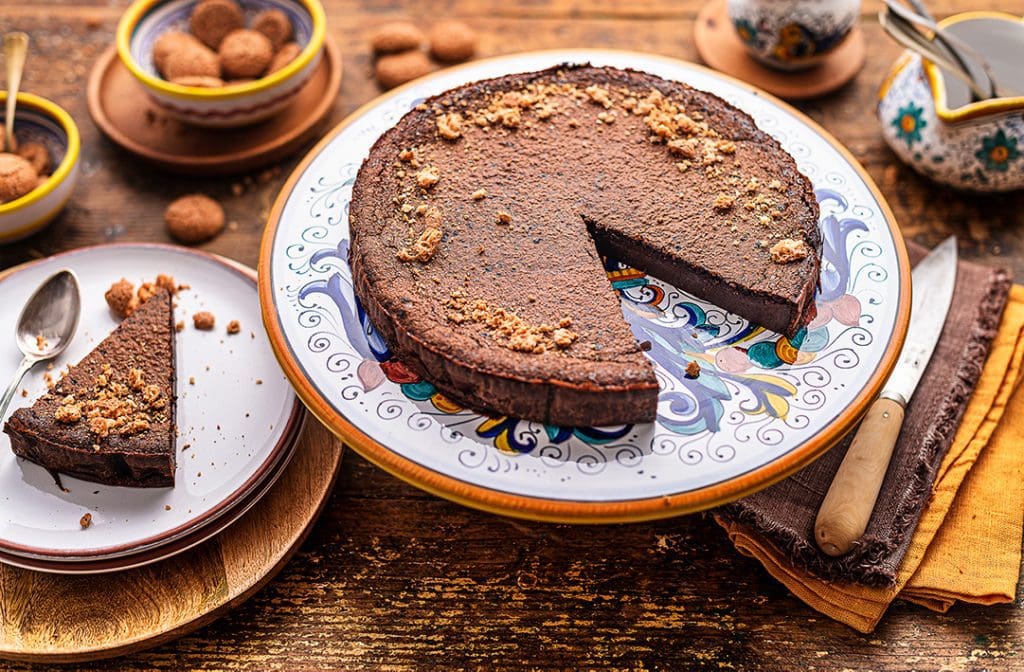
Credit photo
UmbriaTourism
Forchettiere.it
Antonio Gravante
2Amiche in Cucina
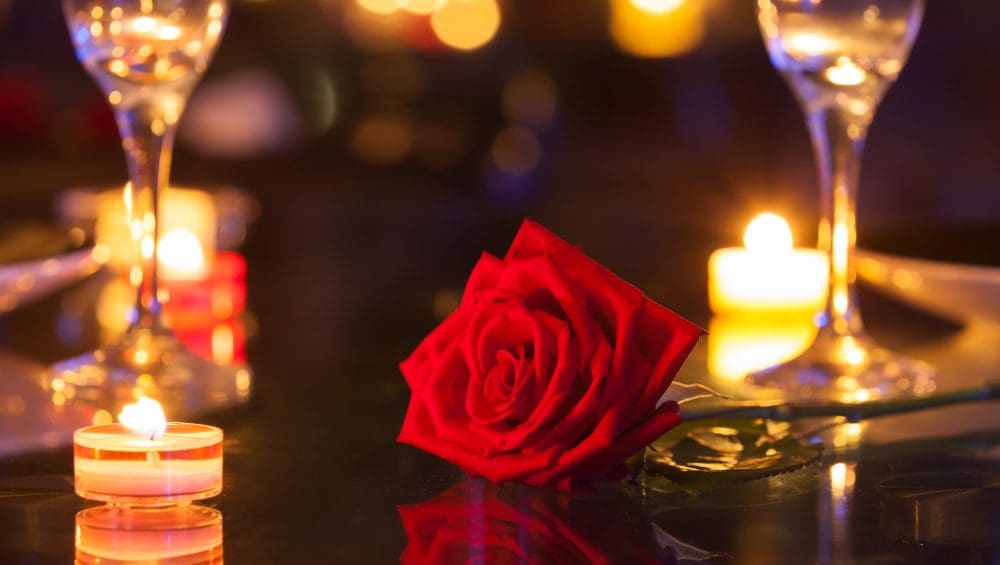
The Legends of Saint Valentine
The story of Saint Valentine of Terni is shrouded in mystery and folklore, with various legends intertwining over the centuries.
Saint Valentine is revered as the patron saint of lovers, and his feast day on February 14th is celebrated worldwide. Valentine was a Christian bishop from Terni, who died as a martyr in Rome on February 14th, 273 AD. He was laid to rest in Terni, in the Basilica where his relics can still be found today.
One of the most famous legends tells that Emperor Claudius II in the 3rd century AD had issued a decree that prohibited the marriage of young men, believing that singles made better soldiers. However, Valentine disobeyed this decree and continued to perform secret weddings for young couples. When his disobedience was discovered, Valentine was arrested and brought before the Emperor. During his imprisonment, legend has it that Valentine healed the blindness of his jailer’s daughter and that, before his execution, he wrote her a farewell letter, signing it “From your Valentine.”
This story has helped to cement Saint Valentine’s association with romantic love. Another version of the Saint Valentine story suggests that he might have been martyred for aiding persecuted Christians during the reign of Claudius II. Yet another legend tells of Valentine witnessing two young lovers arguing and giving them a rose, urging them to hold it together as a way to reconcile, and then having doves fly around them, hence the term “lovebirds.” In any case, the figure of Saint Valentine quickly became a symbol of love and devotion, and his feast day became associated with romantic love over the centuries.

Terni the City of Love and Steel
Do you only have one day to visit Terni? We’ll give you more than one reason to come back!
Morning: Art, history and flavors
Start your day with a stroll through the historic center of Terni. Explore Corso Tacito, among shops and cafes, and stop at the Cathedral of Santa Maria Assunta, an architectural jewel that combines history and beauty.
Continue to the Basilica of San Valentino, the patron saint of lovers. It’s a perfect place to discover a romantic and spiritual side of the city. Touch the tomb of the saint to bring home some luck in love.
Stop at a typical trattoria and let yourself be won over by the flavors of Terni. Try the ciriole alla ternana, similar to strangozzi, they are seasoned with a simple sauce of garlic, oil, tomato and chili pepper., a game dish or a soup of lentils from Castelluccio.
Never end the meal without tasting the dessert symbol of Terni, the Pampepato! A mix of dried fruit (walnuts, almonds, hazelnuts), honey, chocolate, cinnamon and pepper, baked in the oven.
Afternoon: Nature and Wonder
After lunch, head to the incredible Marmore Falls, one of the most exciting natural spectacles in Italy. Walk along the paths that lead to unique panoramic points and enjoy the spectacle of the waters plunging from 165 meters. Let yourself be enveloped by the magic of the sprays and, if you’re lucky, maybe even spot a rainbow. Check the opening times of the water so as not to miss the wow effect!
Evening: Relax and magical sunset
Conclude the day with a visit to Lago di Piediluco, a few kilometers from the waterfalls. This enchanted lake is perfect for relaxing and admiring a fairytale sunset. You can rent a boat or simply walk along the banks, immersed in tranquility. Treat yourself to dinner in a small restaurant on the shores of the lake. Try local fish dishes, such as royal perch, or a pizza accompanied by a good glass of wine. The reflection of the lake at dusk will be the icing on the cake of an unforgettable day. We are waiting for you in Umbria
We are waiting for you in Umbria

What to do in Umbria in February? UmbriaSì tells you
February is the month of Valentine’s Day, and Umbria, with its romantic charm and dreamy landscapes, is the ideal destination to celebrate love. Whether you want to surprise your better half or simply live an unforgettable experience, this land knows how to ignite romance.
Here are our three tips on what to do in Umbria in February
Celebrate love in the land of Saint Valentine
Terni, the birthplace of Saint Valentine, transforms into the beating heart of romance during this month. The Basilica of Saint Valentine hosts the evocative Festa della Promessa, where couples can renew their vows of love. In addition, the atmosphere is enhanced by special events, concerts and markets dedicated to lovers. A perfect opportunity to make your Valentine’s Day truly unique, immersed in a historical and romantic setting.Experiences to share: spa and relaxation for couples
February is the ideal month to indulge in moments of pure relaxation together. Choose a stay in one of the spas immersed in the Umbrian hills, where you can enjoy wellness treatments, couple massages and heated pools with breathtaking views. The intimate atmospheres and suggestive views create the perfect context to pamper yourself and share moments of complicity with your other half.A toast to love: tastings in the cellar
Umbria is a land of great wines and in February the cellars transform into ideal places to celebrate love. Many cellars offer exclusive packages for couples, with romantic toasts among ancient barrels and dreamy views. An experience that combines authentic flavors and unforgettable atmospheres. We are waiting for you in Umbria
We are waiting for you in Umbria 

San Costanzo’s Torcolo
The typical sweet of the tradition to celebrate San Costanzo is, in fact, the Torcolo, behind which there are many legends and mysteries related to the Saint that still today make this sweet full of charm and history.
In fact, it is handed down that the torcolo is in the shape of a donut to remember the crown and flowers that were placed on the body of the Saint after the decapitation or even that the hole represents the severed head of the Saint and lastly that its donut shape refers to the crown paraded from the head of the Saint once he was beheaded. That’s why a dessert studded with colored candies, in memory of the precious stones of the color! The five cuts on the donut are, however, attributable to the access doors to the five districts of the historic center of Perugia: Porta San Pietro, Porta Sole, Porta Eburnea, Porta Susanna, and Porta Sant’Angelo.
The torcolo di San Costanzo, despite the great importance it holds during the feast of January 29, is a dessert that is now enjoyed in Umbria throughout the year!
Let’s see the Recipe:
Ingredients:
600 g of flour
330 g of warm water
170 g of sugar
85 g of extra virgin olive oil
1 egg
85 g of butter
25 g of brewer’s yeast
170 g of candied citron
170 g of sultana raisins
170 g of pine nuts
anise seeds to taste
Method:
Arrange the flour on a pastry board, or in a bowl, crumble the yeast in the center and begin to knead with the warm water, gradually collecting the flour from the edges. Once the dough is homogeneous and well blended, let it rest and rise for about 2 hours in a warm, dry place.
Once the leavening is complete, turn the dough over (it should double) onto the work surface, spreading it slightly with the palm of your hand and add the butter cut into small pieces (room temperature), the sugar and the oil. Once the ingredients are mixed, add the diced candied citron, the raisins, the pine nuts, anise to taste. Knead it until all the candied fruit and dried fruit are well blended, form the donut and put it in a buttered cake pan to let it rise for about 3 hours.
After the last leavening, brush the surface of the Torcolo with egg yolk and make 5 light cuts with the tip of the knife.
Bake in a preheated oven at 180° for about 45 minutes.
Recommended pairing: Vernaccia di Cannara or Umbrian Vinsanto.
Commenti recenti
- A Taste of Umbria 4
- Accomodations 107
- Activity 9
- Attività 3
- Blog 40
- Christmas in Umbria 0
- Consigli 4
- Events in Umbria 3
- La Contessa: a door between land and sea 7
- Mystic Umbria 3
- Nature 2
- News 12
- Packages 29
- Perugino il meglio maestro 3
- Recipe 8
- Taste 4
- Tips 8
- Umbria A Journey through Time 7
- Umbria Beactive 6
- Umbria For Family 10
- Umbria Jazz 7
- Uncategorized 1
-
What to do in Umbria in April? UmbriaSì tells you 29 March 2025
-
Marmore’s Fall 20 March 2025
Via Settevalli, 320
06129 Perugia
Iscriviti per ricevere informazioni su pacchetti, offerte, eventi e manifestazioni in Umbria.
Privacy and Cookie Policy | Credits: GREEN CONSULTING
UMBRIAPERTA: BANDO PER IL SOSTEGNO ALL’ATTIVITÀ DI INCOMING” NUOVO PIANO DI SVILUPPO E COESIONE FSC”
Intervento relativo al Progetto “UmbriaSì per l’Incoming” è stato realizzato e finanziato con RISORSE FSC
La funzionalità del sito web è stato implementa con il sostegno delle risorse del Nuovo Piano di Sviluppo e Coesione FSC





